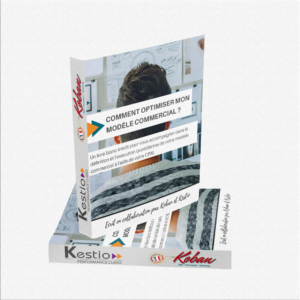Thanks to our previous articles, you have all the keys in hand to build your business model, translate it operationally into your CRM tool, and apply it daily.
This week, we're continuing our momentum by discovering how to successfully structure your sales model and data in your CRM. Indeed, a good sales model can only last if it is based on accessible, relevant, reliable, and usable data! Here's how to make sure they are.
Collect and structure data in your CRM.
The problem with data is that it can change very quickly, and it often needs to be enriched to remain relevant.
Let's take a simple example: employee turnover in a company.
How many responses have you already received to your emails indicating that the contact has "left the company, etc." This is why updating your data is ESSENTIAL, and even VITAL, to sustain your business model.
COLLECT DATA VIA THE CRM
We have already discussed the importance of using relevant data for the proper functioning of your business model. Aside from centralizing all your available data, your CRM tool will allow you to automatically collect very interesting data.
Firstly, some data is easily accessible and available, but not worth entering manually: "generic" data such as turnover, for example, is tedious and time-consuming to enter manually. Fortunately, you can automate the receipt of this type of data via connectors with external sites (such as Corporama). This allows you to automatically retrieve a lot of information and frees up your sales representatives to focus on more "sensitive" information.
In addition to receiving "external" data, you're sure to have internal data in your company that's present in other tools (customer invoicing, production tool, etc.). It may be worthwhile to "bring up" some of this information into your CRM to make the data accessible and usable.
Similarly, by synchronizing your CRM with your information system, you will be able to import the information it contains into other tools, thus avoiding tedious and error-prone double entries. The goal is for relevant information to benefit everyone.
Secondly, a CRM tool will allow you to collect so-called 'personal' data on your customers' / prospects' behaviors. Thanks to the marketing part of your tool, your customers / prospects will be tracked in order to collect information automatically, allowing you to see for each contact:
- The pages of the site he visited – when – and how many times
- If they have opened your quote.
- If they have read the latest email the salesperson sent them.
- If it's a return visit (i.e., if a prospect returns to your site after X amount of time)
- If they have opened, read, or clicked on a button in an email campaign.
- Etc…
In short, this is data that you would not have been able to collect without a tool that does it automatically for you. And this data is very valuable for salespeople. It allows them to judge the level of interest of a contact, their "potential", and thus to refine and enrich your customer knowledge. A "Bronze" customer who reads all your new product emails, clicks on ALL your buttons, and visits your service presentation pages may deserve to be re-qualified as a "Silver" customer? Or at least, it's worth taking a closer look...
Finally, there is the data collected directly by your sales representatives. They are an invaluable source for feeding the CRM with information that you will not find anywhere else (number of machine tools installed, internal validation process, etc.). This data is very heterogeneous and will have to be made usable.
However, we know that sales representatives are often very busy and (sometimes) don't take the time to enter all the data into the CRM. Yet, they know your customers best... To overcome this problem, we can easily add mandatory fields when a sales representative creates a new record. This is quite practical when it comes to data that is essential to the proper functioning of your business model and we realize after 6 months that no one has filled in this field!
STRUCTURE YOUR DATA WITH A CRM
Once again, having data is good, but it is still necessary that this data is centralized, structured and usable. Without this, your business model may not last long...
That's perfect, your CRM is precisely there for that: to centralize data on a single platform and make it accessible.
CRMs offer many practical tips to assist you in this process. Take the example of Koban (with all objectivity, of course! : ))
- You have X contacts on an account record. Perfect, but not all contacts are created equal... Indeed, you're not going to chase up the accountant for your quote, nor the marketing manager for an unpaid invoice. To avoid this kind of mishandling, our CRM displays tags above each contact indicating whether they are the billing contact, the decision-maker, etc.
- Another scenario is that you may want to enter information that is specific to your environment and therefore does not exist 'out-of-the-box' in your tool. Fortunately, any good CRM allows you to add custom fields or objects that you can display on your customer's record.
Let's take a very concrete example: you sell printers to your customers. Some of them have several machines in the company. It is therefore important that you have a clear and direct view of the machine fleet on each of your customer records. In this case, you can create a custom field dedicated to this information and display it in your contact records to collect this data via your sales representatives and make it accessible and usable for your future actions (marketing campaign, segmentation of your base, etc.).
Structure your business model
SALES PROCESSES
Your business model necessarily integrates the management of the sales cycle and the various processes. And that's a good thing, because a good sales tool is there to help you generate more revenue, and more efficiently.
In your CRM, you will be able to implement your sales process according to the segmentation defined by the commercial model (by type of client, by market, by type of offer, etc.). This process, built around the stages of the sales cycle, will allow you to group together all commercial opportunities of the same nature, to monitor their evolution in the commercial process and to easily identify the opportunities that you should prioritize (for example by classifying them by segments: Gold, Silver and Bronze). This gives you a clear and direct view of all your current opportunities, with their probability of success and their level of progress.
The CRM will act as a true assistant for sales representatives, enabling them to monitor all their sales activities, ensure no opportunity is missed, and focus their efforts on the most promising ones (defined according to your business model, of course).

INTERNAL COMMUNICATION
Last important point, communication!
Yes, your business model is based on data but also on its proper execution by your teams.
The goal is to have all your teams working hand in hand and on the same wavelength. No more situations where each salesperson is the only one who holds (in their head) the knowledge of the clients they are in charge of, or where salespeople and marketers don't speak the same language!
Your CRM tool will help you overcome these difficulties and improve internal communication, thereby facilitating the execution of the business model on a daily basis.
Firstly, you obviously have the entire history of your actions / appointments / calls, etc. on your client files, as well as a "comments" field allowing you to add notes, or specific / important points that will be accessible to all users. Are you on vacation for two weeks?
Does a "GOLD" customer contact you during this time? No problem, your colleague can easily take over thanks to the history of actions and your comments on the record!
But that's not all; there are many other features that allow you to improve data communication within your company. The news feed, which includes all the important actions to stay informed every minute of the day, the ability to attach documents to your files...
In short, your CRM tool will support the deployment of your sales model by allowing you to centralize and leverage all your data and by structuring your sales processes.
All this, of course, with one goal: to facilitate the work of your teams, who will be able to rely on a relevant tool to monitor sales activity on a daily basis!
To learn more about CRMs and help you with your projects, find all of our methods and tools here:
1 : And for those who wish to (re-)discover the previous articles in this series, written in collaboration by KESTIO and KOBAN, it's here:
Article 1: What is a business model and how do you build one?
Article 2: 3 key points for building an effective business model
KESTIO and KOBAN, it's a partnership that feels natural: the former supports SMEs in their commercial development through an online sales coaching platform for leaders, managers and sales representatives; the latter helps them to effectively deploy their strategy and commercial actions by generating maximum ROI, via a high-performance CRM solution.
From this meeting was born an idea (which became a desire, then a reality): to combine our skills and visions to support you in defining and implementing your business model!





